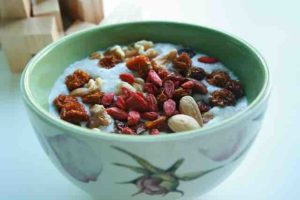Chinese Rice Porridge Health Benefits And Cooking Tips
Chinese congee is an authentic traditional Chinese staple food recipe, a comforting food that can clear the sinusus and nourish the body. Every Chinese has a Granny’s favorite recipe that they grow up with. Rice congee is very easy to make, and it allows countless possibilities. The type of ingredient you choose for your congee is really down to your own preference. And it is the perfect staple food for well flavored dishes, such as Chinese mapo doufu recipe and moo goo gai chicken recipe.
Porridge v.s. Congee
In Mandarin Chinese, we call both porridge and congee “zhou”. So it came to me as a surprise when I learned that porridge and congee are actually different, despite the similar cooking method. Porridge is usually made of oat, whereas congee is made of rice, either plain or whole grains.
Just like chicken soup is considered as universal natural aspirin, Chinese congee (or rice porridge) has many benefits.
Rice Porridge Health Benefits
Body Moisturizing
Rice congee contains up to 90% water. No matter where you live, dry or humid, cold or hot, it is a to-go bowl of water supplement. Not sure? Think about the rice to water ratio. To achieve a medium consistency of rice congee, the ratio is usually 1:8. This ratio can be 1:13 if you fancy a watery thin congee. The water and starch mix up in the congee and can stay in the body longer than other kinds of food, which also alleviates the workload of digestion system.
Weight Control
Compared to rice, rice congee has lower calorie density. A bowl of rice can usually make 4 or more bowls of rice congee. The calorie only lies in starch and protein. By adding more water to the same amount of rice, the calorie in a bowl of rice congee is much lower than a bowl of rice. For example, every 100 grams of rice contains more than 100 kcal, whereas 100 grams thick porridge only contains 30 kcal. Besides, rice congee is more filling than rice, making it easier to lose weight.
Stomach Friendly
Absolutely no harm or burden on your stomach! Our stomach works like a machine. The best “maintenance oil” is rice congee. This is especially true when you have gastrointestinal dysfunction or intestinal infections, diarrhea, etc. Chinese doctors usually recommend having rice congee for a few days after being sick. However, rice congee does’t necessarily mean plain rice. If you really want to ramp up the nutrition factor, try adding some multigrain rice.

How To Cook Congee
Start with the basic ingredients. You’ll only need rice, water, a rice/pressure cooker (or a saucepan with lid). For garnish, add fried scallops, fried peanuts or green onions. Sprinkle some sesame oil if you want. These are optional! Same goes for the amount. Cooking congee is not baking. You don’t need to measure the other ingredients except the rice and water.
Control the rice to water ratio. It’s up to your desired consistency or texture. For a thin texture, apply 1: 8 ratio, which means 1 cup of rice needs 8 cups of water. For a medium and thick texture, the ratio is 1: 10 and 1:13 respectively.
Use Jasmine Rice if possible. Unlike brown rice which usually takes longer to cook, Jasmine rice has the most desired texture when it comes to cooking congee. You can also use leftover rice. It should takes even less time to be ready.
Cook your own congee. No matter what’s left in the kitchen, such as hard boiled eggs, wilted greens, chicken bones or salmon, you can add to your own congee. This makes a great one-dish meal for the entire family. If you have a pressure cooker, that’s even better! With a simple “delay” setting, you can wake up to the perfect bowl of natural goodness!



